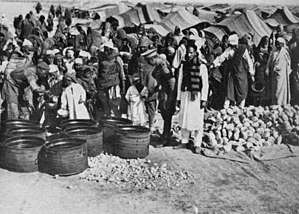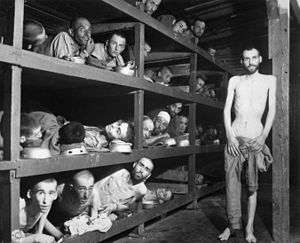Internment

Internment is the imprisonment of people, commonly in large groups, without charges[1] or intent to file charges,[2] and thus no trial. The term is especially used for the confinement "of enemy citizens in wartime or of terrorism suspects".[3] Thus, while it can simply mean imprisonment, it tends to refer to preventive confinement, rather than confinement after having been convicted of some crime. Use of these terms is subject to debate and political sensitivities.[4]
Interned persons may be held in prisons or in facilities known as internment camps. In certain contexts, these may also be known either officially or pejoratively, as concentration camps.
Internment also refers to a neutral country's practice of detaining belligerent armed forces and equipment on its territory during times of war under the Hague Convention of 1907.[5]
The Universal Declaration of Human Rights restricts the use of internment. Article 9 states that "No one shall be subjected to arbitrary arrest, detention or exile."[6]
History and the term "concentration camp"


The American Heritage Dictionary defines the term concentration camp as: "A camp where persons are confined, usually without hearings and typically under harsh conditions, often as a result of their membership in a group the government has identified as dangerous or undesirable."[7]
The United States set up concentration camps for Cherokee and other Native Americans in the 1830s.[8] In 1864, the U.S. government forced 8,000 Navajos to walk more than 300 miles at gunpoint from their ancestral homelands in northeastern Arizona and northwestern New Mexico to an internment camp in Bosque Redondo, a desolate tract on the Pecos River in eastern New Mexico.[9] From 1863 to 1868, the U.S. military persecuted and imprisoned 9,500 Navajo and 500 Mescalero Apache. Living under armed guards, more than 3,500 Navajo and Mescalero Apache men, women, and children died from starvation and disease.[9]
The English term concentration camp was first used in order to refer to the reconcentrados (reconcentration camps) set up by the Spanish military in Cuba during the Ten Years' War (1868–78) and the Cuban War for Independence (1895–98), and similar camps set up by the United States during the Philippine–American War (1899–1902).[10]
The term concentration camp saw wider use around the Second Boer War (1899–1902), when the British operated such camps in South Africa for interning Boers.[10][11] They built 45 tented camps for Boer internees and 64 for black Africans. Conditions were terrible for the health of the internees, mainly due to neglect, poor hygiene, and bad sanitation. Of the 28,000 Boer men captured as prisoners of war, the British sent 25,630 overseas. The vast majority of Boers remaining in the local camps were women and children,[12] over 26,000 of whom died there.[12][13] More than 14,000 Black Africans died in the camps.[14] Welfare campaigner Emily Hobhouse brought to the attention of the British public the appalling conditions inside the camps. The British government set up the Fawcett Commission to investigate her claims, under Millicent Fawcett, which corroborated her account, and resulted in improved conditions.[15]
Between 1904 and 1907, the Imperial German Army operated concentration camps such as the Shark Island, Swakopmund and Lüderitz Bay camps in German South-West Africa (now Namibia) as part of its genocide of the Herero and Namaqua peoples. Eventually, the death rate of the camps reached 45%.[16]
In the late 1930s, over 100,000 defeated or interned personnel of the Spanish Republican armed forces, along with civilians, were held in concentration camps by the government of France, and they included Meheri Zabbens,[17] and the Camp de concentration d'Argelès-sur-Mer in southern France. Some of them managed to go into exile or went off to join the armies of the Allies in order to fight against the Axis powers,[18] while others ended up in Nazi concentration camps.[19]
During the 20th century, the arbitrary internment of civilians by the state reached its most extreme form with the establishment of the Nazi concentration camps (1933–45). The Nazi concentration camp system was extensive, with as many as 15,000 camps[20] and at least 715,000 simultaneous internees.[21] The total number of casualties in these camps is difficult to determine, but the conscious policy of extermination through labor in at least some of the camps ensured that the inmates would die of starvation, untreated disease and summary executions.[22] Moreover, Nazi Germany established six extermination camps, specifically designed to kill millions, primarily by gassing.[23][24]
As a result, some say that today the term "concentration camp" may be conflated with the concept of "extermination camp" and historians debate whether the term "concentration camp" or "internment camp" should be used in order to describe other examples of civilian internment, such as the United States government's internment of Japanese Americans during World War II,[4] the Australian government's immigrant detention facilities,[25][26] and South Korea's detention camps for "undesirables" in the 1970s and 1980s.[27]
See also
References
- ↑ Lowry, David (1976). Human Rights Vol. 5, No. 3 "INTERNMENT: DENTENTION WITHOUT TRIAL IN NORTHERN IRELAND". American Bar Association: ABA Publishing. p. 261. JSTOR 27879033.
The essence of internment lies in incarceration without charge or trial.
- ↑ Kenney, Padraic (2017). Dance in Chains: Political Imprisonment in the Modern World. Oxford University Press. p. 47.
A formal arrest usually comes with a charge, but many regimes employed internment (that is, detention without intent to file charges)
- ↑ "the definition of internment". www.dictionary.com.
- 1 2 "Euphemisms, Concentration Camps And The Japanese Internment". npr.org.
- ↑ "The Second Hague Convention, 1907". Yale.edu. Archived from the original on 9 October 2012. Retrieved 1 February 2013.
- ↑ Universal Declaration of Human Rights, Article 9, United Nations
- ↑ "Concentration camp". American Heritage Dictionary. Retrieved 22 July 2014.
- ↑ James L. Dickerson (2010). Inside America's Concentration Camps: Two Centuries of Internment and Torture. p. 29. Chicago Review Press
- 1 2 M. Annette Jaimes (1992). The State of Native America: Genocide, Colonization, and Resistance. p. 34. South End Press.
- 1 2 "Concentration Camp". The Columbia Encyclopedia (Sixth ed.). Columbia University Press. 2008.
- ↑ "Documents re camps in Boer War". sul.stanford.edu. Archived from the original on 9 June 2007.
- 1 2 Meredith, Martin (2007). Diamonds, Gold, and War: The British, the Boers, and the Making of South Africa Conditions were reputedly even worse in the camps where black Africans were held, but unlike in the Boer camps, death rates were not recorded in the camps where black Africans were held (First ed.). New York: PublicAffairs. pp. 452–56. ISBN 978-1586484736.
- ↑ Knight, Ian (2000). Boer Wars (2): 1898–1902. Men-at-Arms. Oxford: Osprey Publishing. p. 40. ISBN 978-1855326132.
- ↑ Thomas Pakenham (1991), The Scramble for Africa, 1876–1912, Random House, New York. pp. 580–581.
- ↑ Porch, Douglas (2013). Counterinsurgency: Exposing the Myths of the New Way of War. p. 73. Cambridge University Press.
- ↑ Evans, Richard J. (2003) The Coming of the Third Reich New York: Penguin Press. p.345. ISBN 0-14-303469-3
- ↑ "Almirante Valdés (VS o AV)". marinarepublicana.blogspot.com.
- ↑ 24 au 26 août 1944 Libération de Paris par les chars... espagnols de la nueve
- ↑ "Wayback Machine" (PDF). archive.org. 28 May 2013.
- ↑ Concentration Camp Listing Sourced from Van Eck, Ludo Le livre des Camps. Belgium: Editions Kritak; and Gilbert, Martin Atlas of the Holocaust. New York: William Morrow 1993 ISBN 0-688-12364-3. In this online site are the names of 149 camps and 814 subcamps, organized by country.
- ↑ Evans, Richard J. (2005). The Third Reich in Power. New York: Penguin Group. ISBN 978-0-14-303790-3.
- ↑ Marek Przybyszewski, IBH Opracowania – Działdowo jako centrum administracyjne ziemi sasińskiej (Działdowo as the centre of local administration). Internet Archive, 22 October 2010.
- ↑ Robert Gellately; Nathan Stoltzfus (2001). Social Outsiders in Nazi Germany. Princeton University Press. p. 216. ISBN 978-0-691-08684-2.
- ↑ Anne Applebaum, A History of Horror, Review of "Le Siècle des camps" by Joël Kotek and Pierre Rigoulot, The New York Review of Books, 18 October 2001
- ↑ Charles, Stephen (4 May 2016). "Our detention centres are concentration camps and must be closed". The Sydney Morning Herald.
- ↑ "No Pacific paradise: Trump's call to PM shines light on detention camps". nbcnews.com.
- ↑ "South Korea covered up mass murder of vagrants before 1988 Olympics". New York Post. Associated Press. 19 April 2016.
External links
